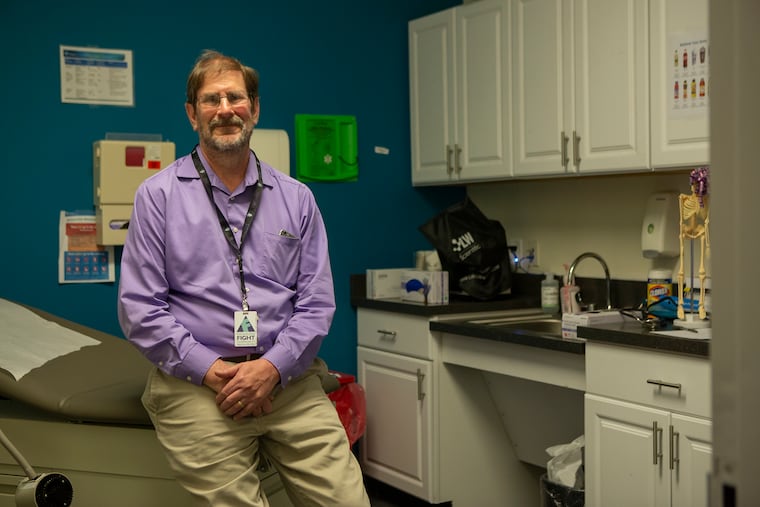Medical Mystery: A doctor had stroke symptoms, but then he listened to his heart and discovered a different diagnosis
After seven hours in the hospital, doctors said he probably had a transient ischemic attack (TIA) or mini stroke. It wasn’t until the next morning that he realized none of the doctors he saw had listened to his heart.

On a cold, overcast February morning, Jay Kostman woke up with his left arm tingling.
The 60-year-old physician wasn’t concerned — he thought maybe he had slept on his arm the wrong way. He ate breakfast and by the time he left his Allentown, N.J., home for his commute to Center City, where he works as the medical director for Philadelphia FIGHT Community Health Centers, the odd feeling was gone.
But when he was getting on the PATCO train, he noticed his left leg felt “heavy.” By the time he reached his stop, Kostman had a hard time lifting his leg up the stairs, and his gait was off.
“I was thinking I was having a stroke,” he said.
Kostman took an aspirin, called a colleague who agreed he needed to be evaluated, and within minutes he was in an Uber to Pennsylvania Hospital.
At the emergency room, a neurologist examined him immediately, as he had been deemed a “stroke alert," and ordered blood tests and a CT scan of his brain.
“I have no risk for stroke,” Kostman said. He was not a smoker, he didn’t have heart disease, his blood pressure was normal, he did not have diabetes, and he didn’t have a facial droop, one of stroke’s telltale signs. “I was thinking this is weird,” he recalled.
The CT scan didn’t show evidence of a stroke, but it did show something that prompted doctors to order an MRI. That test confirmed what’s called a “false aneurysm,” which can occur when a blood vessel is injured and blood collects in the surrounding tissue. But it was in his left parietal lobe, which meant it didn’t account for the symptoms he was having, Kostman said.
After seven hours in the hospital, doctors remained unsure of what caused his episode and said he probably had a transient ischemic attack (TIA), or mini stroke. They advised he schedule a neurology follow-up in four weeks for a repeat MRI and then sent him home with prescriptions for aspirin and a statin, which helps control high cholesterol.
“I was just short of shell-shocked, to put it bluntly,” said Kostman. “In retrospect, I wasn’t thinking clearly. I was relieved initially that there was no stroke.”
It wasn’t until the next morning when Kostman realized that his evaluation had been focused only on his neurological symptoms. None of the doctors he saw had listened to his heart.
Kostman dug up an old stethoscope he kept at home and placed it on his chest.
“I was shocked by what I heard, it was so loud,” said Kostman.
Solution:
He discovered a heart murmur that wasn’t there six months before when he had his annual physical exam.
All the pieces suddenly fell together: the new murmur, the leg pain, the false aneurysm. Kostman, an infectious-disease specialist, realized he had mitral valve endocarditis, a bacterial infection of his heart valve.
Stethoscope still in his hand, Kostman told his wife, Donna Huryn, he needed to get to a hospital immediately. They drove to Penn Medicine Princeton Medical Center.
His diagnosis was confirmed at the emergency room and he was admitted. Four days later he was transferred to Penn Presbyterian Medical Center in Philadelphia, where he worked for 17 years, for heart surgery to repair his valve.
Kostman was hospitalized for 30 days with a cascade of medical events and complications.
A cardiac catheterization, which was performed in advance of his heart surgery, found that his leg pain was caused by a clot in an artery that was related to the endocarditis and needed to be removed. The false aneurysm he was originally diagnosed with was actually a mycotic aneurysm that formed as a result of the bacterial infection. That required another procedure and placement of a coil in his brain to prevent further bleeding.
A previously damaged tooth needed to be extracted before the heart surgery. He had an adverse reaction to one of the drugs he was taking. After surgery his heart rhythm became irregular and he needed a pacemaker implanted. He also developed an ulcer he attributes to the stress of being in the hospital.
By the time Kostman was discharged from the hospital, he was about 30 pounds lighter, tired and weak from inactivity. He needed intravenous antibiotics for an additional three weeks at home and had to complete a cardiac rehab exercise program. He is now back at work.
“I think my prognosis is good,” he said.
Kostman’s condition was congenital. Both his mother and brother had mitral valve prolapse, but his doctors had not previously heard a murmur in his heart.
Kostman doesn’t think the ultimate outcome would have been different if someone had listened to his heart during his initial emergency-room visit, though it would have saved him the trip home and back.
But Kostman said if someone had asked about his family history, he likely would have remembered his brother’s and mother’s heart conditions.
The physical examination is an important skill and should always include a complete history, he said, observing that medicine too often relies on diagnostic tests over talking to patients.
His advice for patients: Always ask for a thorough exam, and whether there could be an alternative diagnosis.